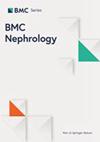A case of heavy-chain deposition disease with good long-term renal survival and a literature review
IF 2.4
4区 医学
Q2 UROLOGY & NEPHROLOGY
引用次数: 0
Abstract
Monoclonal immunoglobulin deposition disease (MIDD) is characterized by the deposition of nonamyloid monoclonal immunoglobulin and its free fragment light chain and/or heavy chain in systemic tissues and organs, and the kidney is most vulnerable organs. MIDD can be divided into three types: light-chain deposition disease (LCDD), light and heavy chain deposition disease (LHCDD), and heavy-chain deposition disease (HCDD), of which LHCDD and HCDD are rarer (Bridoux et al. in Kidney Int 2015;87:698–711; Preud’homme et al. in Kidney Int 1994;46:965–72). Poor outcome in most HCDD, but in this paper, we will report a case of HCDD with good long-term renal survival and review the literature for reference. A 32-year-old man presented to our department with skin laxity and nephritic syndrome, accompanied by an significant increase of serum creatinine and received short-term hemodialysis treatment. Both the blood and urine free light chain ratio increased significantly. Renal biopsy showed mesangial nodular glomerulosclerosis on light microscopy, and immunofluorescence staining showed positivity for γ-heavy chain (HC), with negative light chain (LC) staining; the diagnosis was considered HCDD. After six courses of bortezomib combined with dexamethasone chemotherapy and thalidomide 100 mg/day, the renal function gradually recovered, while also with proteinuria and hematuria significantly improved. The blood and urine free light chain ratio decreased to normal. Until now, the patient has been followed for four years, and long-term renal survival has been observed. Herein, we report a case presenting with proteinuria, hematuria, renal impairment, and skin laxity, and a renal biopsy showed linear IgG deposition in the glomerular basement membranes and tubular basement membrane. However, they ultimately proved to have HCDD. Bortezomib combined with dexamethasone, and oral thalidomide led to a good long-term renal survival. We also provide a review of currently available literature, and this is the first large-scale review summarizing the characteristics of HCDD up to date.一例长期肾功能良好的重链沉积症病例及文献综述
单克隆免疫球蛋白沉积病(MIDD)的特征是非淀粉样单克隆免疫球蛋白及其游离片段轻链和/或重链在全身组织器官中沉积,而肾脏是最易受影响的器官。MIDD 可分为三种类型:轻链沉积病(LCDD)、轻重链沉积病(LHCDD)和重链沉积病(HCDD),其中 LHCDD 和 HCDD 较为罕见(Bridoux 等,载于 Kidney Int 2015;87:698-711;Preud'homme 等,载于 Kidney Int 1994;46:965-72)。大多数 HCDD 的预后较差,但本文将报告一例长期肾脏存活良好的 HCDD 病例,并回顾文献以供参考。一名 32 岁男子因皮肤松弛和肾炎综合征就诊于我科,伴有血清肌酐显著升高,并接受了短期血液透析治疗。血液和尿液游离轻链比值均明显升高。肾活检光镜下显示系膜结节性肾小球硬化,免疫荧光染色显示γ-重链(HC)阳性,轻链(LC)染色阴性;诊断为HCDD。经过六个疗程的硼替佐米联合地塞米松化疗和沙利度胺 100 毫克/天治疗后,患者的肾功能逐渐恢复,蛋白尿和血尿也明显改善。血尿游离轻链比值降至正常。迄今为止,该患者已接受了四年的随访,并观察到长期肾功能存活。在此,我们报告了一例出现蛋白尿、血尿、肾功能损害和皮肤松弛的病例,肾活检显示肾小球基底膜和肾小管基底膜有线性IgG沉积。然而,他们最终被证明患有 HCDD。硼替佐米联合地塞米松和口服沙利度胺使患者获得了良好的长期肾脏存活。我们还对现有文献进行了综述,这是迄今为止第一篇总结 HCDD 特征的大规模综述。
本文章由计算机程序翻译,如有差异,请以英文原文为准。
求助全文
约1分钟内获得全文
求助全文
来源期刊

BMC Nephrology
UROLOGY & NEPHROLOGY-
CiteScore
4.30
自引率
0.00%
发文量
375
审稿时长
3-8 weeks
期刊介绍:
BMC Nephrology is an open access journal publishing original peer-reviewed research articles in all aspects of the prevention, diagnosis and management of kidney and associated disorders, as well as related molecular genetics, pathophysiology, and epidemiology.
 求助内容:
求助内容: 应助结果提醒方式:
应助结果提醒方式:


